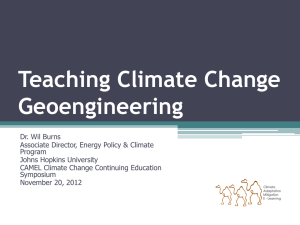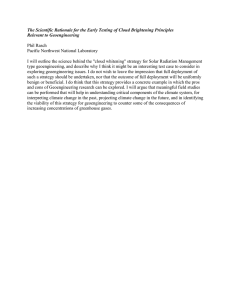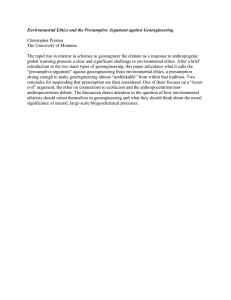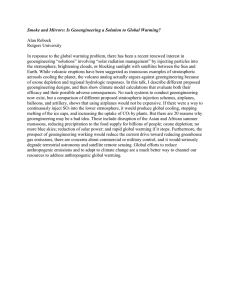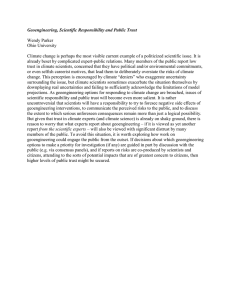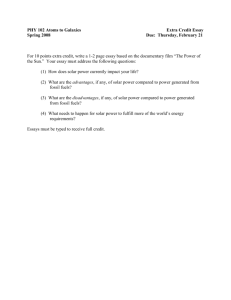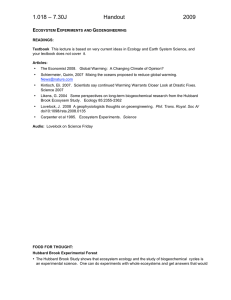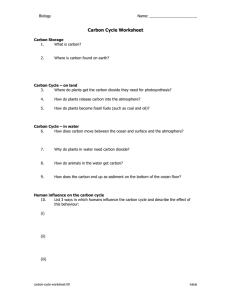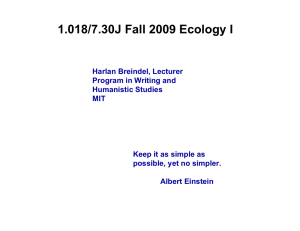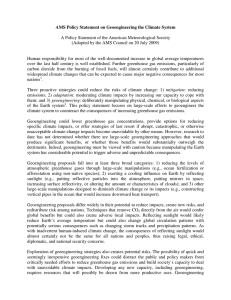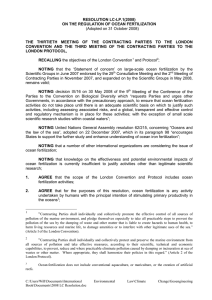Remaking the World to Save It:
advertisement
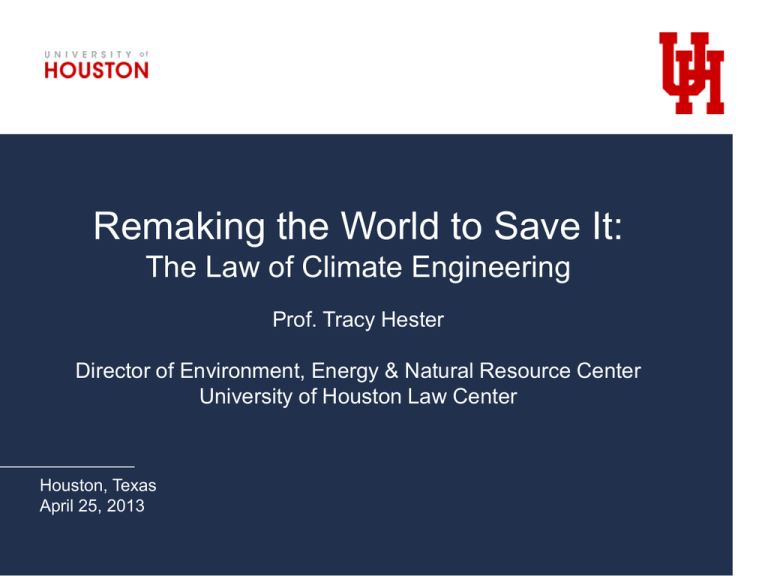
Remaking the World to Save It: The Law of Climate Engineering Prof. Tracy Hester Director of Environment, Energy & Natural Resource Center University of Houston Law Center Houston, Texas April 25, 2013 Geoengineering - “Plan B”? • Geoengineering is the deliberate large-scale manipulation of the planetary environment to counteract anthropogenic climate change • Treated as a fringe subject for decades, and still highly controversial • Key point: proposal by Dr. Paul Crutzen in 2006 Why even consider climate engineering? U.S. Hydrocarbons Production 130.0% Production Index (2007=100%) 125.0% 120.0% U.S. Commodity Prices 115.0% • Henry Hub Natural Gas prices lowest since 1999 110.0% 105.0% 100.0% • Crude oil prices still at high levels 95.0% 90.0% • Corn prices have tripled since 2005 85.0% 80.0% NG Prod Index Crude Oil Prod Index Burning all fossil fuels would produce a different, practically uninhabitable, planet. …. It seems implausible that humanity will not alter its energy course as consequences of burning all fossil fuels become clearer. Yet strong evidence about the dangers of human-made climate change have so far had little effect. Whether governments continue to be so foolhardy as to allow or encourage development of all fossil fuels may determine the fate of humanity. Climate Sensitivity, Sea Level, and Atmospheric CO2 James Hansen, Makiko Sato, Gary Russell and Pushker Kharecha (2013) Climate Change and Hopes for Diplomatic Solutions • Climate Change – a “Super Wicked” Problem – Requires collective action – Immediate sacrifice for remote gains by future generations – Justice and equity concerns (“climate debt”) • Not surprisingly, difficult to achieve consistent and coordinated action – Failure of Waxman-Markey and domestic U.S. legislation • Limited mitigation under current laws – The U.N. Process -- Cancun Agreements and Doha – Major international or domestic action unlikely in near future • Some have proposed geoengineering or climate engineering as an important fall-back strategy Types of Climate Engineering • Solar Radiation Management • Carbon Dioxide Removal • Temperature Sink Management • Regional Chemical Strategies Solar Radiation Management • Focus on reducing the amount of solar energy reaching the Earth’s surface • Key examples – – – – Stratospheric aerosol releases Cloud whitening Surface albedo enhancement Satellite reflectors Stratospheric Aerosol Releases • Mimic global cooling caused by volcanic eruptions • Effectiveness: half-ounce of SO2 offsets one ton of CO2 global temperatures reduced by 2 degrees C • Requirements: 5 million tons of SO2 annually $1 billion to $50 billion annually Geoengineering trials get under way Updated 17:10 14 September 2011 by Michael Marshall Magazine issue 2829. Volcanic ash inspires sunshade (Image: Arctic Images/Corbis) • – Update 14 September 2011: The field test will be conducted at an abandoned airfield in Sculthorpe, UK. Matthew Watson of the University of Bristol, UK, presented details of the project at the British Science Festival in Bradford, UK. Field trials for experiments to engineer the climate have begun. Next month a team of UK researchers will hoist one end of a 1-kilometrelong hose aloft using a balloon, then attempt to pump water up it and spray it into the atmosphere. Other Solar Radiation Management Options Carbon Dioxide Management • Enhance absorption of carbon dioxide and other greenhouse gases from atmosphere • Techniques: – – – – Afforestation Ocean fertilization Mechanical removal of CO2 Biochar Haida Ocean Fertilization 100 tons of iron sulfate Dispersed into coastal waters off British Columbia in July 2012 Plankton bloom and salmon runs By Haida Salmon Restoration Corp. Search warrants executed by Canada Environment Plans to renew iron fertilization in 2013 Eyes to salmon run in 2014 Heat Sink Temperature Management • Even out temperature differences that can drive disruptive weather and water events • Example: ocean heat pumps driven by wave energy Ocean Acidification – Washington State Comparison of Climate Engineering Options and Risks Comparisons of climate change methods What Laws Apply? • No clear body of law applies directly and overtly to climate engineering (except offensive military use clearly banned) • Convention on Biological Diversity • London Convention and London Protocol • Customary International Law • Domestic laws – United States and other nations What’s Next? • Upcoming Fifth Assessment Report under the International Panel on Climate Change • Regional climate engineering • Climate attribution • Unilateral regulation? • Intellectual Property • Rights of minorities and human rights implications Questions? Professor Tracy Hester University of Houston Law Center tdheste2@central.uh.edu 713-743-1152 (office)
